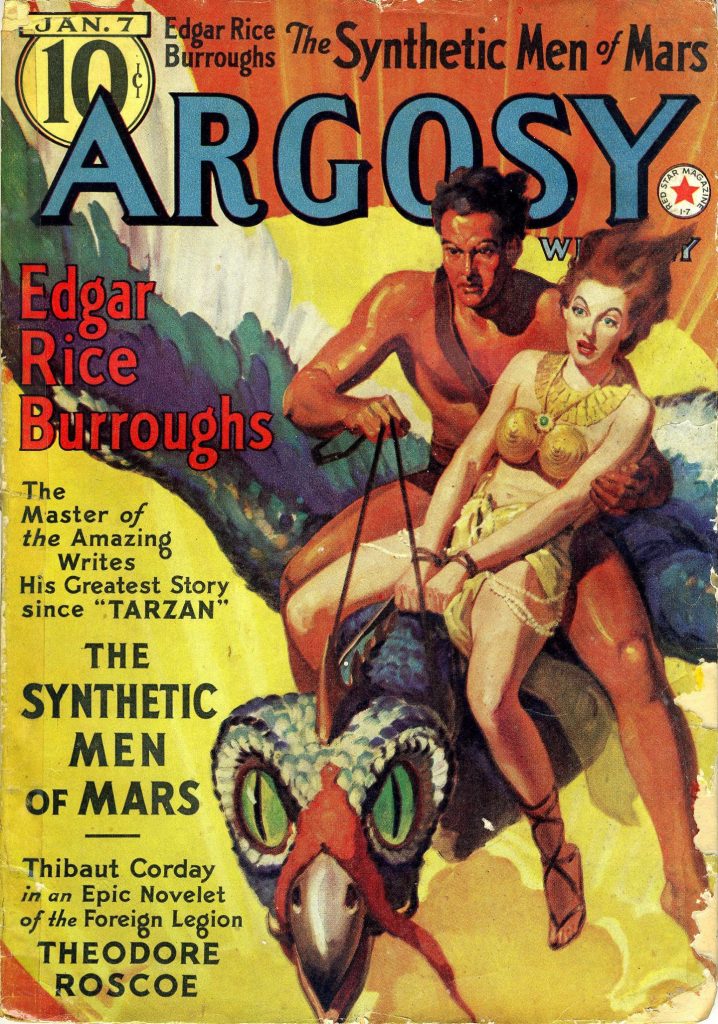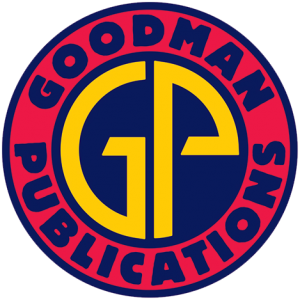
Edgar Rice Burroughs and The Pulps: The Expansion of Genre Fiction
by Ryan Harvey
The first pulp magazine was Argosy, which changed to an all-fiction format in 1896. Each issue delivered a thick stack of stories printed on low-cost paper. More pulp magazines followed, and by the 1920s, they had changed the way people across the country consumed fiction. They made reading stories of wild adventures, Western action, granite-jawed private eyes, shadowy superheroes, and the new worlds of science fiction and fantasy into popular pastimes. The pulps didn’t survive the 1950s, but the reading habits they created did—as did the genres they fixed into the popular imagination.
It might never have happened if not for one author, Edgar Rice Burroughs, who turned the smaller, general interest pulp field into a wide-open extravaganza of high adventure and bizarre new vistas in 1912—sixteen years after the modest start with Argosy.
Burroughs was born in Chicago in 1875. Until he sold his novel Under the Moons of Mars to All-Story (part of the magazine group that owned Argosy), he’d struggled through an unremarkable career of unsuccessful business ventures and a brief stint in the military that he mostly spent ill with dysentery. While trying to pass the time as a manager for pencil-sharpener salesmen, Burroughs wrote a story about a human adventurer transported to a wild frontier version of Mars.

Despite no extensive fiction writing background, Burroughs’s imagination proved formidable. When Under the Moons of Mars appeared as a serial in All-Story starting in February 1912, readers were dazzled at the swashbuckling action and spectacular visions of his Martian setting. Protagonist John Carter was an early superhero, capable of gargantuan leaps and immense feats of strength in the lesser gravity of Mars. He fought with and alongside towering green Martian warriors and rescued the beautiful red-skinned princess Dejah Thoris. Readers had never seen anything like it in the pulps. Retitled A Princess of Mars for book publication, the story started a series of Martian adventures that stretched over the rest of Burroughs’s life.
Later in 1912, All-Story published in one issue a complete Burroughs novel: Tarzan of the Apes. And then the pulp universe exploded. Readership skyrocketed, and the magazines multiplied to meet demand. (How popular was Tarzan? In a letter to All-Story’s editor, Burroughs wrote, “About a score of readers here have threatened my life unless I promise to write a sequel to Tarzan—shall I?”)
By the 1920s, the pulps had expanded into a sprawl of titles to feed every reading hunger. Adventure, Western Story, and Black Mask dominated the most popular genres: exotic adventure, Western action, and hardboiled-crime—the latter entirely a pulp invention thanks to the success of writers Carroll John Daly and Dashiell Hammett in Black Mask. Readers who liked romance had a selection of titles as well: Love Story from Street & Smith was one of the company’s top sellers.

The pulps explored oddball niche genres. Zeppelin Stories and Strange Suicides didn’t have enough of an audience to survive more than a few issues, but publisher Frank Armer apparently thought they were good ideas. At least Zeppelin Stories was around long enough to combine apes and lighter-than-air aircraft in “The Gorilla of the Gasbags” by Gil Brewer, one of the holy grails of pulp weirdness. Armer would later be the editor behind another significant pulp genre, the adventure + sex “spicy” magazines.
As for science fiction and fantasy, other authors followed Burroughs’s lead in delivering strange and otherworldly thrills. The most popular writer in fantasy after Burroughs was A. Merritt, whose serial The Moon Pool was one of the most loved science-fiction/fantasy adventures of the next thirty years. When the first SF magazine, Amazing Stories, started in 1926, the genre found a dedicated home. The next year, E. E. “Doc” Smith burst onto the scene with the first star-spanning space opera, The Skylark of Space. Soon Amazing was joined by other SF pulps, Wonder Stories and Astounding Stories. Astounding eventually became the home of the “Golden Age” of SF in ‘40s under editor John W. Campbell.
The final thread in the pulp genre tapestry was Weird Tales, a monthly magazine serving a mixture of fantasy, horror, and science fiction. Although never a steady seller, Weird Tales provided a venue for H. P. Lovecraft’s cosmic horrors, Clark Ashton Smith’s necromantic fantasies drenched in eldritch prose, and the fantasy action of Robert E. Howard. Weird Tales was the exclusive home of Conan the Cimmerian during Howard’s lifetime. Editor Farnsworth Wright also discovered genre luminaries C. L. Moore, Seabury Quinn, Robert Bloch, and Henry Kuttner.
Through all this, Edgar Rice Burroughs continued as a pulp superstar. He wrote more than twenty Tarzan novels. He sent a submarine to The Land That Time Forgot and drilled deep in At the Earth’s Core. The Martian stories marched on, and Burroughs started a new series on Venus.

Burroughs’s popularity waned in the 1940s, as did the pulps. The country’s reading habits started to switch to the new format of paperbacks, and younger readers moved to comics. Burroughs died in 1950, and by then only a few pulps survived—among them Astounding, which changed its name to Analog in 1960 and has never ceased publication.
But the spirit of Edgar Rice Burroughs and the pulps continued into the paperback boom and helped genre reading grow and grow. Paperback editions of Burroughs’s novels turned into perennial sellers in the early ‘60s and fueled interest in literary science fiction and fantasy. When The Lord of the Rings, first published in hardback without fanfare in 1954–55, arrived in paperback in 1965, it leaped to the top of the best-seller lists. Fantasy changed from a small subgenre into its own bookstore section.
Today, almost every category the pulps created or expanded thrives with readers. Even Zeppelin Stories returned in the shape of steampunk. Still not enough gorillas, though.


